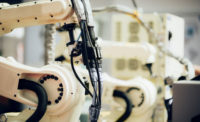Over the last two years, we have all sought ways to protect ourselves and those around us from harmful bacteria and viruses, and these efforts will likely continue well into the future. These additional precautions, which have become an integral part of daily routines, will translate into professional environments as employees begin to return to their workspaces in the new year. With the influx of people returning to office environments, health and safety will continue to be a number one priority for business leaders across all industries.
For those tasked with oversight of employee wellness, finding new ways to enhance sanitization and hygiene practices continues to be top of mind. Adding protective measures and innovative health and safety products in high-touch areas can help slow down the spread of harmful germs, especially in the workplace. Therefore, these measures and products will play a crucial role in helping to keep everyone safe as we attempt to navigate a return to normalcy.
Making the spaces where we live and work safer with new product innovations is critical.
Because of the COVID-19 pandemic, everyone is hyper-aware of the many surfaces we touch on a daily basis, but prior to the pandemic, many facilities managers and industry leaders have always battled different bacterial and viral transmissions in the workplace. While the COVID-19 pandemic has certainly heightened awareness, many are seeking ways to make their spaces cleaner and free from all kinds of bacteria and viruses. Facilities managers have turned to new product innovations like disinfectant lighting, hands-free controls and antimicrobial paint and coatings to help supplement current sanitation practices by providing an additional barrier against bacteria and viruses.
Antimicrobial paint exemplifies the use of innovation to ensure products are providing extra precautions. When applied to interior surfaces, functional coatings have the ability to kill viruses and bacteria on the painted surface, which, in turn provides a barrier for commercial spaces. It is a relatively cost effective, easy-to-apply solution for businesses that want to add an extra layer of protection against harmful microbes to working spaces.
Antimicrobial paint can be used on interior walls, trim and doors, proving to be versatile in high-traffic areas, such as workplaces where staff members share office spaces. In settings where people are frequently coming and going, like breakrooms, restrooms and even employee fitness centers, antimicrobial paint can be used as a barrier against bacteria and viruses.
The attributes and benefits of antimicrobial paint
There are many benefits to applying antimicrobial paint, most prominently that they have the ability to kill 99.9% of viruses and bacteria on painted surfaces. However, not all antimicrobial paints are made equal. To make sure that you’re getting the most protection out of the product, you should ensure that the paint has certain attributes. For instance, in order to achieve a 99.9% efficacy rate against harmful germs on surfaces, antimicrobial paints need to go through an extensive testing process and be registered by the EPA. It should also offer mold and mildew resistance on the dry paint film, to ensure that it can be applied in a variety of settings like kitchens and bathrooms and withstand the wear and tear typically experienced by surfaces of high-traffic areas.
Finally, just because a paint product has antimicrobial capabilities doesn’t mean that performance should be a trade-off. Antimicrobial products should provide the same durability and premium application properties that customers expect from regular paint products, so it’s easy to use and maintains its appearance once applied. Additionally, it should come in different paint colors and sheens, so it can be used in a variety of settings and customized to personal taste. Both paint professionals and at home DIYers should be able to easily use an antiviral/antibacterial product in commercial and residential settings.
As we continue to look for ways to limit the spread of harmful bacteria and viruses, antimicrobial products can provide peace of mind when used in a variety of spaces. Whether used at home, in retail spaces or in healthcare facilities, antimicrobial paint can provide a barrier to supplement disinfection precautions already in place.









